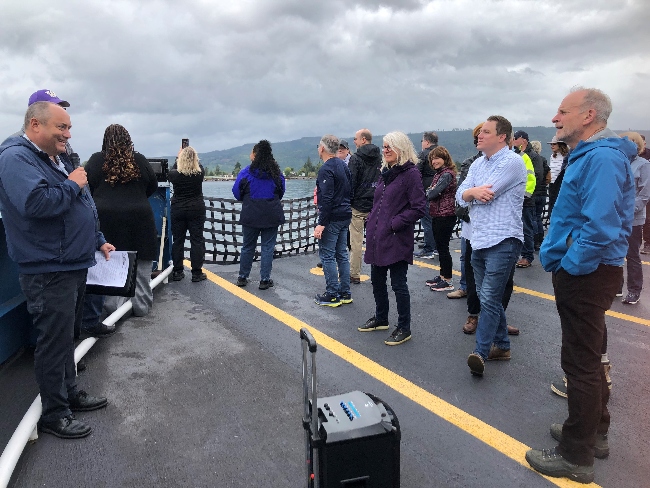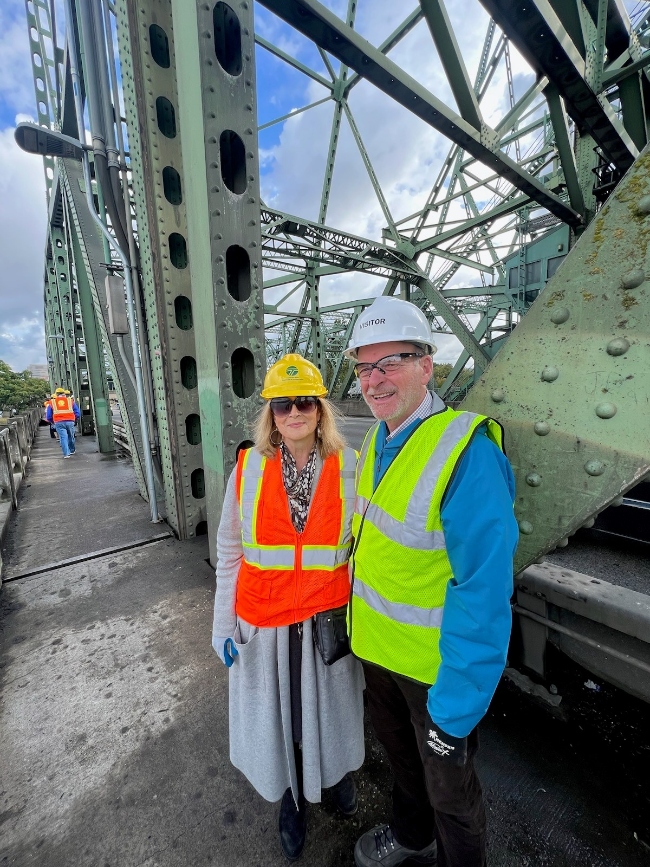Dear friends and neighbors,
It’s hard to believe that the 2023 Legislative Session is now almost half a year behind us and that we’re now gearing up for the 2024 Legislative Session, now just three months away.
This past spring and summer, I was quite busy in our district and throughout the state, where I often met with fellow government officials, key stakeholders, as well as so many of you! The coffee chats I did with Speaker Laurie Jinkins and Sen. Yasmin Trudeau were quite positive and it was great to see so many of you ask questions of us in person!
A couple weeks ago, in my role as the House Transportation Chair, I had the opportunity to schedule a three-day tour of bridges in southwestern Washington. Organized by the Legislature’s Joint Transportation Committee (JTC), this group is a bipartisan, bicameral legislative agency that conducts transportation-related studies and other activities to inform legislators and associated staff. This tour was a terrific opportunity for us to see up close and personal how our state’s transportation dollars are being utilized to improve the bridges we saw that are so vital to connecting people, as well as goods and services, between Washington and Oregon. Below, I provide some insight into what we witnessed and are current challenges in Southwest Washington.
Day 1
Beginning our tour in Aberdeen, we listened to WSDOT officials describe the issues of the five bridges the agency maintains in Aberdeen and Hoquiam and the urgent need they face for either maintenance or complete replacement.
WSDOT ranks the state’s 3,377 bridges as either “good,” “fair,” or “poor.” Unfortunately, the bridges in this area are all ranked “poor.” In an ideal world, two or even three of the five would be slated for replacement, but the state does not have the necessary funds, or the sufficient workforce, to take all this on immediately.
The (Aberdeen) Daily World picked up on this story, which you can read here for more information. This is a topic that I’m certain lawmakers on both sides of the aisle and across the rotunda will be debating and working together towards solutions during the next legislative session, so please stay tuned.
Our first day also included a presentation on the Astoria-Megler Bridge, the first of several Columbia River border crossings our group traversed.
Towards the end of the day, we rode the Oscar B ferry from Westport, Oregon, to Puget Island, Washington. Wahkiakum County operates the Oscar B and has operated a ferry here since 1962. It is the state’s last ferry on the lower Columbia River. Last session, I co-sponsored a bipartisan bill to address the operation and maintenance deficit of this important ferry.

Day 2

Legislators and staff continued to hear from WSDOT and ODOT officials about the importance of their relationship with one another. Of the nine Columbia River bridges, WSDOT and ODOT share responsibility, stewardship, and funding for the operations, maintenance, and repair of seven of the nine bridges. These bridges are nationally and regionally critical to the movement of people and goods and they are essential to the bi-state communities served by them. These communities rely on each other for vital services sharing residential centers, employment centers, industries, educators, first responders, hospitals and health care access, transportation options, food access, and more.
Shared state responsibility includes regular maintenance, addressing emergent maintenance and weather issues, operating bridge systems, regular inspections to identify capital investments and subsequently implement them, and planning necessary expenditures between the states and communicating critical information to the public when closures are necessary to conduct this work. This approach encourages both states to support border bridge maintenance and capital investments as top-tier priorities.
The image below shows the Bridge of the Gods, known to many through-hikers of the Pacific Crest Trail that traverses 2,660 miles from the U.S. border with Mexico to the U.S. border with Canada, going through significant portions in Washington and Oregon. It is a dangerous bridge for pedestrians and bicyclists. Annual traffic crossings average about 1.6 million vehicles. The annual value of goods that cross the bridge is approximately $35 million per year. Revenues from the bridge pay for maintenance, painting, inspections, and bond repayment. While the original cost to build the bridge was $602,077 a century ago, today it would cost around $270 million to replace the bridge. This bridge will most certainly be receiving attention from legislators in both states in upcoming legislative sessions, and I’ll update you on the progress once there is more to share.

Another highlight of this second day was seeing the Hood River-White Salmon Bridge, which is slated for replacement. Two years ago, a new bridge was estimated to cost $500 million, but now with inflation, it’s likelier to be closer to $520 million. To date, $118 million has been secured in funding to replace this bridge. Of the total funding, $80 million has come from Washington and Oregon has committed to $20 million in its 2023 budget.
Day 3
Our trip concluded with a morning presentation from the I-5 Interstate Bridge Replacement Program before heading out to see this bridge and its control tower connecting Vancouver and Portland. The Columbian reported on this; click here to see more.
With one span of this bridge now over 100 years old, it is at risk for collapse in the event of a major earthquake, and it no longer satisfies the needs of modern commerce and travel. Replacing this bridge with a modern, seismically resilient, multimodal structure that provides improved mobility for people, goods and services is a high priority for Oregon and Washington. My friend and colleague Rep. Sharon Wylie (D-Vancouver) sponsored a bill to replace the current bridge in the 2019 Legislative Session, and so it was especially fulfilling to for us to see the progress that has been made and to talk about what is still needed to get this work done.

Officials estimate that it will cost roughly $6 billion to replace this bridge, with a combination of funds used from bills passed in both the Washington State and Oregon legislatures, tolling revenue and federal funds. A large portion of money for this project ($1 billion) was passed during the 2022 Legislative Session with the historic $17 billion, 16-year Move Ahead Washington transportation package, which was recently contested in the courts and upheld by the Washington State Supreme Court just a couple weeks ago. In its 2023 legislative session, Oregon also allocated $1 billion in funding.
Bi-state legislative involvement is essential to successfully complete the planning and design process and move to construction. Each state legislature has identified eight lawmakers (including myself) to provide direction and oversight to shape this work. Based on the program’s current schedule, it is estimated that construction could begin in late 2025 or early 2026. Plus, the best news of all? Once this work commences, it is expected Washington will add thousands of jobs to complete this project. This is another topic I’m sure I’ll be telling you more about in the years to come.
Sincerely,

